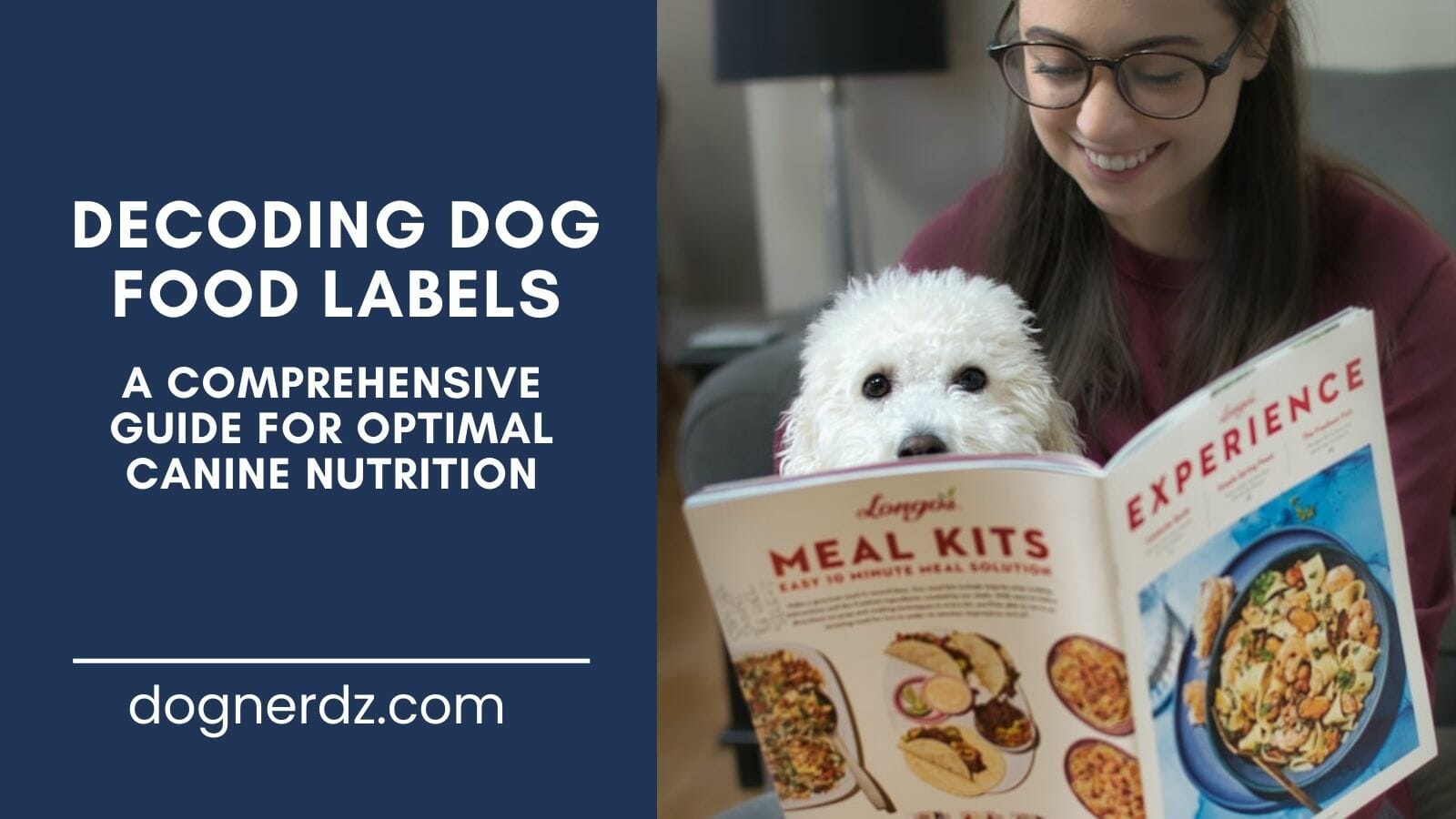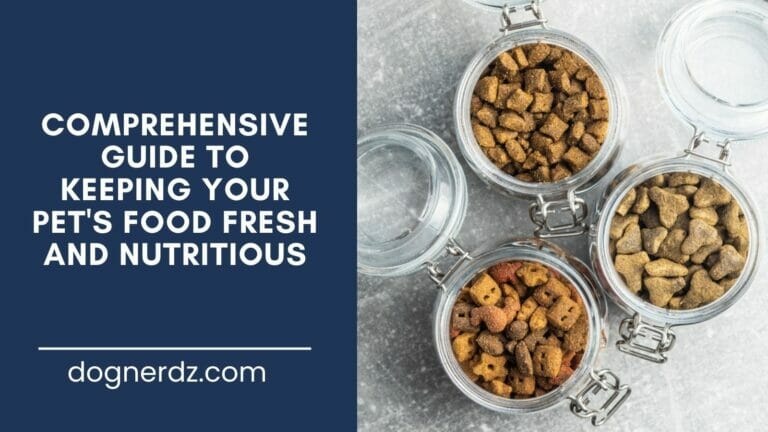Decoding Dog Food Labels: A Comprehensive Guide for Optimal Canine Nutrition
As dog owners, we all want what’s best for our furry friends, and proper nutrition plays a crucial role in their overall health and well-being. But with so many dog food options available, it can be overwhelming to decipher what’s actually in those bags and cans.
That’s where dog food labels come in.
In this article, we’ll explore the basics of dog food labels and how to understand them for better pet nutrition.
Table of Contents
Why Dog Food Labels Matter
Dog food labels are not just fancy packaging; they contain essential information that can help us make informed decisions about what we feed our dogs. Proper nutrition is vital for their growth, energy levels, and overall health. By understanding dog food labels, we can ensure that we’re providing our furry friends with the nutrients they need.
Regulatory standards for dog food labeling are set by institutions such as the Association of American Feed Control Officials (AAFCO) and the Food and Drug Administration (FDA). These standards ensure that the information on the labels is accurate and reliable. However, there are still misconceptions and common misunderstandings about dog food labels that we need to be aware of.
One such misconception is the belief that dog food labels are just marketing claims. While it’s true that some labels may contain misleading information, such as the terms “premium” or “gourmet,” it’s important to look beyond the fancy packaging and focus on the actual content of the food.
Key Components of Dog Food Labels
To understand dog food labels, let’s break them down into their key components. The product name and brand may seem insignificant, but they can give us an idea of the product’s quality and reputation.
Ingredient list
This is where we find valuable information about what’s actually in the dog food. It’s important to look for high-quality ingredients and to understand the order in which they are listed. Ingredients are listed by weight, so the first few ingredients are the most abundant in the food.
Guaranteed Analysis Section
This provides information on the macronutrients in the food, such as protein, fat, and carbohydrates. Understanding these ratios and ensuring a balanced diet is crucial for our dogs’ health. Let’s break down what each number means:
- Crude Protein
This represents the total protein content in the dog food. Dogs require a diet rich in protein to support their muscle development and overall health. Look for a dog food that contains at least 18-22% crude protein for adult dogs and 22-32% for puppies.
- Crude Fat
Fat is a concentrated source of energy for dogs and provides essential fatty acids. Look for a dog food that contains around 10-15% crude fat for adult dogs and 8-22% for puppies.
- Crude Fiber
Fiber aids in digestion and helps regulate bowel movements. Look for a dog food that contains around 2-5% crude fiber.
- Moisture
Moisture content represents the amount of water in the dog food. Dry dog food typically contains around 10% moisture, while wet dog food can contain up to 80% moisture.
Here’s a simple table that compares the nutritional values of different ingredients commonly found in dog food:
| Ingredient | Protein | Fat | Fiber | Moisture |
|---|---|---|---|---|
| Chicken | High | Medium | Low | High |
| Beef | High | High | Low | High |
| Chicken Meal | Very High | Medium | Low | Low |
| Beef Meal | Very High | High | Low | Low |
| Chicken By-Products | Medium | Low | Low | High |
| Beef By-Products | Medium | Low | Low | High |
| Corn | Low | Low | High | Low |
| Wheat | Low | Low | High | Low |
| Soy | Medium | Low | High | Low |
Notes:
- Protein: Essential for growth, repair, and maintenance of body tissues. Animal sources like chicken and beef are high in protein, while plant sources like corn, wheat, and soy are lower.
- Fat: Provides a concentrated source of energy and essential fatty acids. Animal sources like beef have higher fat content than plant sources like corn, wheat, and soy.
- Fiber: Aids in digestion and helps regulate bowel movements. Plant sources like corn, wheat, and soy are high in fiber.
- Moisture: Represents the amount of water in the ingredient. Fresh meats like chicken and beef have high moisture content, while rendered meals and plant sources have low moisture content.
Remember, this table is a simplified representation. The actual nutritional value can vary depending on the quality of the ingredient and the processing methods used. Always consult with your veterinarian or a pet nutrition expert for personalized advice.
Nutritional Adequacy Statement
This tells us whether the food is complete and balanced for a specific life stage, such as puppy, adult, or senior. It’s important to interpret this statement correctly to ensure that our dogs are getting the nutrients they need.
Feeding Instructions
This provides guidance on portion sizes and factors that can affect our dogs’ feeding requirements, such as age, size, and activity level. Overfeeding can lead to weight gain and other health issues, so it’s essential to follow these instructions and consult a veterinarian if needed.
Manufacturer’s Information On The Label
This can give us insight into the company’s values, ethics, and commitment to quality. It’s important to choose reputable brands that prioritize the health and well-being of our furry friends.
Understanding Common Dog Food Terms and Marketing Tricks
Dog food labels are not just about the ingredients; they also include various terms and marketing claims that can be confusing. Terms like “natural,” “organic,” “grain-free,” “gluten-free,” “by-products,” and “meal” have specific meanings that we need to understand.
For example, “natural” means that the ingredients have undergone minimal processing, while “organic” refers to ingredients that have been grown without synthetic pesticides or fertilizers. “Grain-free” and “gluten-free” mean that the food does not contain grains or gluten, which can be beneficial for dogs with certain dietary restrictions or sensitivities.
On the other hand, “by-products” and “meal” are not necessarily bad ingredients. By-products are the parts of the animal that are not commonly used for human consumption, such as organs and bones.
They can be a valuable source of nutrients for our dogs. Similarly, meal refers to ingredients that have been ground or processed into a dry, powdered form, which can be more concentrated in nutrients.
It’s important to be aware of misleading marketing claims and not get swayed by terms like “premium” or “gourmet.” The packaging and branding of dog food can influence our perception, but it’s the actual content of the food that matters.
Additional Information on Dog Food Labels
Beyond the key components of dog food labels, there are other pieces of information that can be helpful. The AAFCO statement tells us whether the food meets the nutritional standards set by the organization. Country of origin and manufacturing information can give us insight into the quality and safety of the product.
Nutritional claims are regulated by authorities to ensure that they are accurate and reliable. Caloric content and calorie distribution can help us manage our dogs’ weight and overall health.
Reading Beyond the Label – The Role of Dog Food Recalls
Dog food recalls are not uncommon, and understanding their significance is crucial for our dogs’ safety. Recalls happen when there is a potential health risk associated with a specific batch or brand of dog food.
We can check for dog food recalls on the FDA website or through other reliable sources. Being aware of recalls and taking appropriate action can help protect our dogs from potential harm.
Making Informed Decisions: Tips for Choosing the Right Dog Food

When it comes to choosing the right dog food, there are a few factors to consider. Firstly, we need to take into account our dog’s specific needs, such as their age, breed, and any health conditions they may have.
Seeking professional advice from veterinarians or animal nutritionists can provide valuable guidance. Researching reputable brands and reviewing independent evaluations can help us make informed decisions. When transitioning between dog food brands, it’s important to do it gradually to avoid digestive upset.
Case Study: Comparing Labels of Different Dog Food Brands
To put our knowledge into practice, let’s compare the labels of different dog food brands. By selecting a range of brands and types of dog food, we can dissect and compare their labels. Understanding the differences and similarities between labels can help us make informed decisions about what’s best for our dogs.
Conclusion
Understanding dog food labels is essential for providing our furry friends with the nutrition they need. By reading and deciphering labels, we can make informed decisions and ensure that our dogs are getting high-quality, balanced meals.
Remember to consider their specific needs, seek professional advice, research reputable brands, and review independent evaluations. With proper nutrition, we can give our dogs the best chance at a healthy and happy life.
Additional Resources:
- Dog Food Advisor: https://www.dogfoodadvisor.com/
- The Whole Dog Journal: https://www.whole-dog-journal.com/
- Tufts University Cummings School of Veterinary Medicine: https://vetnutrition.tufts.edu/



